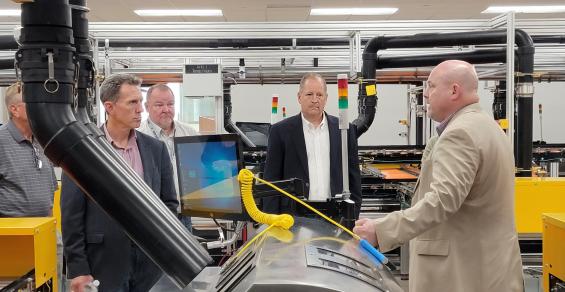National Cotton Council CEO calls U.S. classing system the “gold standard. We class every bale, unlike any other country in the world.”
The new Lubbock, Texas, USDA Cotton Classification Complex is months away from its grand opening and using its fully automated lab to class the 2022 cotton crop.
National Cotton Council CEO/President Gary Adams recently toured the 30,000-square foot facility. “I got a sneak peek, and I will say it is an impressive facility — state-of-the-art all the way around,” Adams says. “It is a real testament to USDA in terms of the cotton program, how they’re working to be as efficient as possible, to be as timely as possible in classing the crop, just making use of technology. It’s a very impressive facility.”
National Cotton Council President/CEO Gary Adams (Photo by Shelley E. Huguley)
In 2021, USDA’s 10 labs, located across the Cotton Belt, classed 17.1 million cotton samples, according to Darryl Earnest, USDA AMS Cotton and Tobacco Program deputy administrator. Lubbock’s previous lab, classed 3.4 million samples. The new facility, located on the Texas Tech University campus, is equipped to process 50,000 to 60,000 samples per day. Earnest says he hopes to class more, and “make it perform at the level that we designed it for.”
Adams describes USDA’s classing system as the gold standard. “We class every bale, unlike any other country in the world,” he says.
The data generated by the new state-of-the-art facility will benefit both producers and U.S. cotton clients. “The level of detail provided is another step forward that will continue to provide quality information that producers rely on for marketing their crop, but also for our customers because we want U.S. cotton to continue to be the preferred fiber.”
A room with a view:Tour guests view the fully automated classing lab from inside a classroom that was built with the intention of being used for future tours and educational purposes. (Photo by Shelley E. Huguley)
This data also compliments information provided to cotton buyers through the U.S. Cotton Trust Protocol. “The USDA classing system has always been a part of our story,” Adams says.
The protocol, a relatively new initiative, is “where we want to tell our sustainability credentials and be able, again, to demonstrate to our customers, U.S. cotton is the right cotton to buy, is the right cotton for their product lines,” Adams says.
Completion delays
With the 2022 season on the horizon, Earnest says the classing lab is “basically finished.” Like much of the country, supply chain issues have caused delays and therefore prolonged completion by 10 months. He says the complex still lacks a few key equipment pieces.
USDA AMS Cotton & Tobacco Program, from left, Deputy Administrator Darryl Earnest, Assistant to the Deputy Administrator Jennifer Turpin, and Associate Deputy Administrator Robbie Robbins. (Photo by Shelley E. Huguley)
“We’re waiting on our air compressor system that provides compressed air to the instruments. We’re also waiting on our bale press. All of that is either on its way or being refurbished. We’re also waiting on some of our audio-visual system, which helps monitor instrument output and testing.
“We’ve still got some security systems and stuff like that to be installed, so still a few things left to go in the building before we’re completely finished. But operationally, we’ve got most of the components. We just need to get them hooked up.”
Looking ahead, Earnest says labor is a concern. Labor was a major issue in 2021 across all the USDA classing labs. “It affected our ability to provide timely service, especially here in Lubbock, and other locations,” Earnest says. “I’m very concerned about it going into this season because I don’t know that a lot has changed in the labor front for seasonal labor, which is where we get a lot of our people.”
Inside the classing lab: from left, Jennifer Turpin, deputy administrator assistant, and Deputy Administrator Darryl Earnest, USDA AMS Cotton & Tobacco Program; National Cotton Council President/CEO Gary Adams; USDA AMS Administrator Bruce Summers; National Cotton Council Member Services Representatives Rick King and Susan Everett; and USDA AMS Cotton & Tobacco Associate Deputy Administrator Robbie Robbins. (Photo by Shelley E. Huguley)
See, NCC’s Gary Adams talks cotton planting, farm bill, exports
USDA is elevating its efforts to recruit employees. “There was a mandatory federal minimum wage that was enacted back in January, so now all of our seasonal positions are at least $15 an hour, which we hope will make us more competitive against a lot of the other entities that use part-time labor.”
Planning for the best
Despite the region’s drought, Earnest says they are planning for the best this season. “A lot of the areas around Lubbock need rain, and some are getting it. Whether or not they’ll get enough to make the kind of crop they want, we’ll have to wait and see. So, we’re going to plan for something similar to what we did last year. We hope we get that. If we don’t, we’ll be equipped.”
Earnest says it’s not the overall crop size that matters as much as the daily gin receipts. “So, even though the overall crop may not be as big, we might see the same level of daily receipts if all the gins are up and running.”
If so, he says they’ll be ready.
*Editor’s Note: A final date has not yet been set for the ribbon-cutting ceremony. More information to come.




